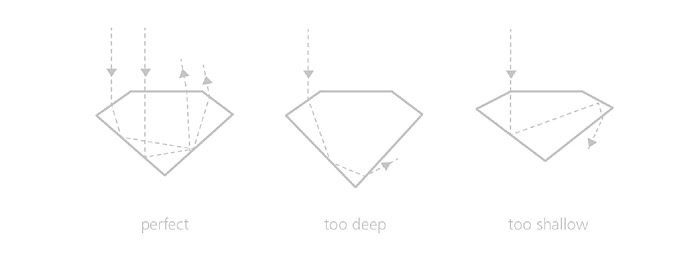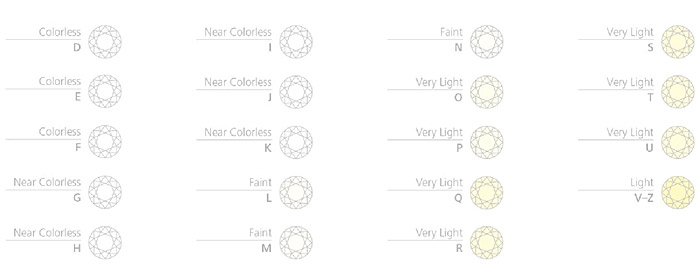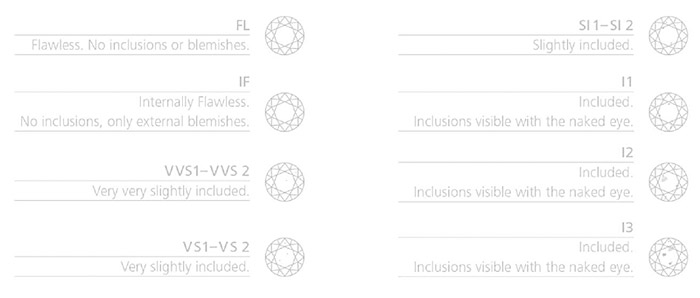The special quality of our diamonds - for our unique jewellery, wedding rings and engagement rings
When selecting diamonds, we do not only observe the 4 C’s, we also place great value on further criteria such as symmetry and the polishing of diamonds.
The origin of our diamonds
Henrich & Denzel guarantees that all of their diamonds come from legitimate sources and are in compliance with UN Resolutions 1171, 1173, 1306 and 1343. These resolutions demand that all raw diamonds, regardless of the place of origin, must have the so-called Kimberly Certificate, which must be issued in the country of origin. This certificate confirms that the raw diamonds being exported are from a legal source
This place of origin certificate is the start of the so-called “System of Warranties”, under which all serious diamond cutters and dealers commit themselves to dealing with diamonds that are only “conflict-free”.
The quality criteria for diamonds
Diamonds used by Henrich & Denzel are graded according to the regulations of the IDC. The decisive quality criteria are weight, color, clarity and cut of the diamonds.
Certification by internationally recognized institutes is provided for all stones 0.5 carat and higher. In our online diamond database all diamonds are GIA certified.
Cut
When seeking beauty in a diamond we consider cut to be the most important of the 4Cs for you to focus on as it determines the way light meets your eye in three ways, brilliance, fire and scintillation.
- Brilliance is the total light reflected from a diamond.
- Fire describes the dispersion of light into the colors of the spectrum.
- Scintillation describes the flashes of light, or sparkle, when a diamond is moved.
A good cut reflects the light trough the right proportions and the arrangement of the facets: The light is reflected from one facet to another and than shines back through the upper part of the stone. The cut also describes the shape of the diamond. It is differentiated between brilliant-, navette-, carré-, princess- and baguette-cut.
The way of light in a diamond In a diamond cut to exact proportions, light is reflected from one facet to the next and then dispersed through the upper part of the stone. If the cut of the diamond is too deep, then the light does not reflect back to the top, but escapes out the other side. If the cut of a diamond is too shallow, then the light escapes through the bottom before it can be reflected.
In a diamond cut to exact proportions, light is reflected from one facet to the next and then dispersed through the upper part of the stone. If the cut of the diamond is too deep, then the light does not reflect back to the top, but escapes out the other side. If the cut of a diamond is too shallow, then the light escapes through the bottom before it can be reflected.
Cut is a very tricky subject that is often over-simplified when presented to the consumer, even (by necessity) on the very best certificates. This simplification obscures the differences in how each stone ‘greets the eye’ (known as ‘faces-up’ in gem jargon). The GIA, fortunately ever conservative, avoids over-simplifying the complexity of describing excellence in cutting. They refuse to put a ‘brand name’ on cutting, eschewing terms such as ‘ideal cut’.
So how is the grade of cut determined? Cut is a combination of each stone´s proportions, measurements, angles, faceting accuracy and polish. For round brilliant cuts only, there are now criteria (thousands of computer-modeled angles and measurements) from which cut-grade can be determined and GIA certificates, issued since January 2006, do so.
Simply put, if a round brilliant diamond is cut to those specifications (excellent or very good) it will be wonderfully brilliant. If not, it will be less so. While a stone may be a top color or clarity and as large a carat weight as anyone could wish for, if the cutting isn’t beautiful, the stone will lack some brilliance, fire and scintillation, thus some of its ‘life’.
For fancy shape diamonds (everything but round is called fancy shape) there are no measurements, angles or relationships yet available to safely determine cut grade. Even stones that have great grades for symmetry or polish are often ‘dark’ as the cutting proportions are wrong. There are literally thousands of combinations a cutter could choose in cutting a fancy shape diamond so they vary wildly in the way they ‘face up’ (we’ve seen fancy shapes weighing 4 carats that are smaller than a 3 carat).
Color
Diamonds were formed deep within the earth under extreme heat and pressure and so often contain trace elements that add a ‘tint’ to them.
The closer the diamond is to colorlessness the higher it is evaluated. The most rare and white ones are graduated with “colorless” (D, E) or “near colorless” (F, G). Most of the diamonds however are white or white-toned and are graduated with “H” to “L”. Henrich & Denzel exclusively uses “colorless” or “near colorless” diamonds.
Next to that, there are also diamonds with strong pure colors, which are extremely rare. They are known as “Fancies” and can be found in the colors of pink, blue, yellow among many others.
Clarity
The brilliance of the diamond is defined by the reflection of the light. If the pass of the light in the diamond is interrupted, for example by inclusions, a part of the light is lost.
The clarity of a diamond is identified by the non-existence of inclusions.
The scale of grading goes form internally flawless (IF) to Very, Very Slightly Included (VVS, VS) through to the biggest inclusions, which are visible to the naked-eye from Slightly Included (SI1). Not only the size of the inclusion but also the color and position are criteria for grading the clarity. The more clarity a diamond has, the rarer it is.
For beautifully cut round brilliants (and other cuts based on the brilliant such as pears, ovals, cushions, hearts, marquise, princess and radiants) where the amount of light dispersion baffles the eye, consider buying these clarities (if given by GIA certification).
- Most carefully chosen SI 1 stones.
- Almost all VS 2 stones
- Practically all VS 1 stones
- All VVS 2, VVS 1, IF,FL stones
Cut stones like emerald cut and asscher cut, because they have less facets, are more ‘open’ to the eye. This means it’s usually (but not always) necessary to go a grade or two higher if you don’t want to see any inclusions.
- A very occasional SI 1.
- Most carefully chosen VS 2 stone
- Most carefully chosen VS 2 stone
- Most carefully chosen VS 2 stone
- All VVS 1 to FL stones
For our collections of jewelry, engagement rings and wedding rings we focus on a strict diamond selection to offer outstanding quality.

